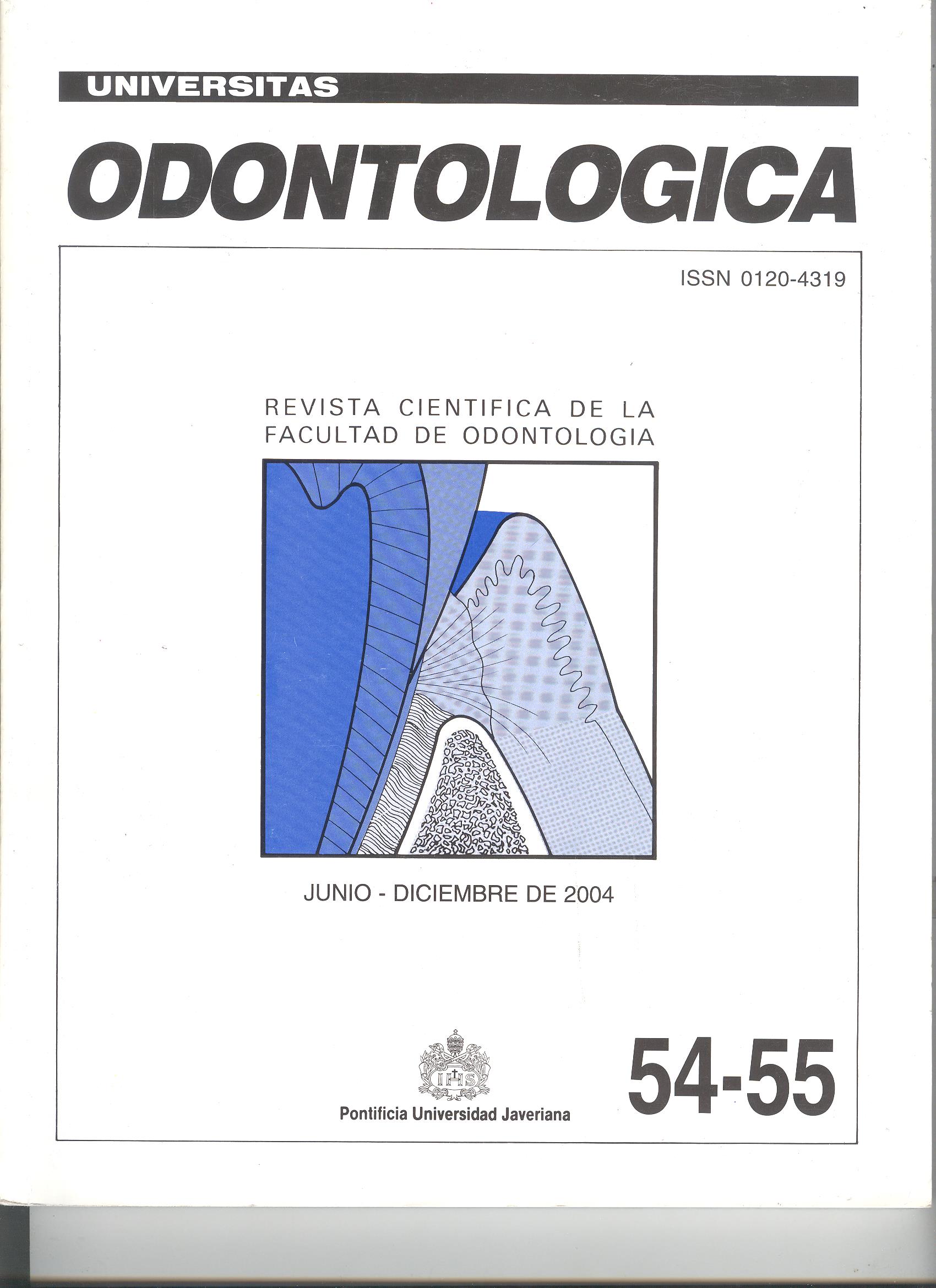Abstract
OBJECTIVE: The purpose of this case
report with observational design, was
to identify the periradicular healing in a
24-month follow-up when using any of
this materials, amalgam without zinc or
MTA. METHODS: The sample consisted
of 22 upper anterior teeth from 19
patients, 6 male and 13 female. The
patients were attended in the period April
2000 - February 2002, in two different
clinics of Bogota, Colombia. Each
patient signed an informed consent
accepting to participate in the study.
The assignment to any of the two
groups of root end-filling materials was
randomized. Then, 11 teeth were filled
with MTA and 11 with amalgam without
zinc. RESULTS: It was found clinically
that one tooth filled with amalgam
without zinc was sensitive in
observations at first and third months.
Radiographically, one tooth filled with
amalgam without zinc showed
unsatisfactory healing when observed
at month 15. Four teeth filled with MTA
and two with amalgam without zinc
presented complete healing 6 months after retro-obturation. Seven patients
presented complete healing, nine filled
with MTA and two with amalgam without
zinc when observed at month 24.
CONCLUSIONS: Sensitive was
observed in teeth filled with amalgam
without zinc, while those filled with MTA were asymptomatic. Radiographically, surgeries carried out with MTA showed better and quicker bone neoformation in different evaluation periods.
Torabinejad M, Watson TF, Pitt Ford T. Sealing ability of a mineral trioxide aggregate when used as a root-end filling material. J Endod 1993 Dec; 19(12): 591-95
Torabinejad M, Higa R, McKendry D, Pitt Ford T. Dye leakage of four root-end filling materials: Effects of blood contamination. J Endod 1994 Apr; 20(4): 159-63
Fischer E, Arens D, Miller C. Bacterial leakage of mineral trioxide aggregate as compared with zinc-free amalgam, intermediate restorative material, and Super EBA as a root-end filling material. J Endod 1998 Mar; 24(3): 176-79
Torabinejad M, Rastegar A, Kettering J. Bacterial leakage of mineral trioxide aggregate as a rootend filling material. J Endod 1995 Mar; 21(3): 109-12
Torabinejad M, Hong C, Pitt Ford T, Kettering J. Cytotoxicity of four root-end filling materials. J Endod 1995 Oct; 21(10): 489-92
Lin L, Skribner J, Shovlin F Langeland K. Periapical surgery of mandibular posterior teeth: anatomical and surgical considerations. J Endod 1983 Nov; 9(11): 496-501
Schoeffel J, Sci M. Apicectomía y procedimientos de retrosellado para dientes anteriores. Clin Odontol Nort Am 1994 Abr; 38(2): 277-97
Frank A, Glick D, Patterson S, Weine F. Longterm evaluation of surgically placed amalgam fillings J Endod 1992 Aug; 18(8): 391-8
Guzmán H. Biomateriales odontológicos de uso clínico, 1ª ed. Bogotá, D. C., Colombia: Cat, 1990
Craig R. Materiales de odontología restauradora, 10ª ed. Hartcourt-Brace, 1998
Torabinejad M, Pitt Ford T. Root-end filling materials: A review. Endod Dent Traumatol 1996 Jan; 12: 161-78
Cohen S, Burns R. Pathways of the pulp. 7th Ed. Saint Louise, MO, USA: Mosby, 1998
Torabinejad M, Hong C, McDonald F, Pitt Ford T. Physical and chemical properties of a new rootend filling material. J Endod 1995 Jul; 21(7): 349- 53
Schwartz R, Mauger M, Clement D, Waker W. Mineral trioxide aggregate: A new material for Endodontics. J Am Dent Assoc 1999 Jul; 130: 967-75
Johnson B. Considerations in the selection of a root–end filling material. Oral Surg Oral Med Oral Pathol Oral Radiol Endod 1999 Apr; 87(4): 398- 404
Block M, Bushell A. Retrograde amalgam procedures for mandibular posterior teeth. J Endod 1982 Mar; 8(3): 107-12
Gutmann JL, Harrison JW. Posterior endodontic surgery: anatomical considerations and clinical techniques. Inter Endod J 1985 Jan;18(1): 8-34
Torabinejad M, Smith P, Kettering J, Pit Ford T. Comparative investigation of marginal adaptation of mineral trioxide aggregate and other commonly used root-end filling materials. J Endod 1995 Jun; 21(6): 295-9
Rud J, Andreasen JO, Moller J. A follow-up study of 1000 cases treated by endodontic surgery. Int J Oral Surg 1972; 1:215-28
Meryon SD. The effect of zinc on the biocompatibility of dental amalgam in vitro. Biomaterials 1984 Sep;5(5): 293-7
Kimura J. A comparative analysis and non-zinc alloys used in retrograde endodontic surgery. Part 1: Apical seal and tissue reaction. J Endod 1982 Aug; 8(8): 359-63
Johnson J, Anderson R, Pashley D. Evaluation of the seal of various amalgam products used as root-end fillings. J Endod 1995 Oct; 21(10): 505-8
Walton R, Torabinejad M. Endodoncia, principios y práctica, 2ª ed. México DF, México. McGraw- Hill Interamericana, 1996
Torabinejad M, Chivian N. Clinical applications of mineral trioxide aggregate. J Endod 1999 Mar; 25(3): 197-204
Halse A, Molven O, Grung B. Follow-up after periapical surgery: The value of the one-year control. Endod Dent Traumatol 1991; 7: 246-50
Ramachandran N, Sjögren U, Figdor D, Endo D, Sundqvist G. Persistent periapical radiolucencies of root-filled human teeth, failed endodontic treatments, and periapical scars. Oral Surg Oral Med Oral Pathol Oral Radiol Endod 1999 May; 87: 617-27
Grung B. Periapical surgery in the Norwegian Hospital County. J Endod 1990; 16: 411-7
Chong B, Pitt Ford T. Radiological assessment of the effects of potential root-end filling materials on healing after endodontic surgery. Endod Dent Traumatol 1997; 13: 176-9

This work is licensed under a Creative Commons Attribution 4.0 International License.
Copyright (c) 2004 Laura Helena Ballesteros Sarabia, Marcela Baquero Zea, María Fernanda Serpa Vélez, Jorge Enrique Delgado Troncoso


